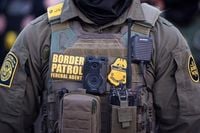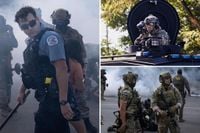On the morning of October 4, 2025, Chicago’s Southwest Side became the flashpoint of a dramatic and violent confrontation between federal law enforcement and protesters, highlighting the city’s ongoing struggle with immigration enforcement and the mounting tensions between local and federal authorities. The incident, which unfolded near West 39th Street and South Kedzie Avenue in Brighton Park, set off a cascade of clashes, political recriminations, and legal maneuvers that have since gripped the city and drawn national attention.
According to reporting from ABC News and CNN, the chaos began when Marimar Martinez, 30, and Anthony Ian Santos Ruiz, 21, allegedly used their vehicles to strike a car occupied by three U.S. Customs and Border Protection (CBP) agents. Prosecutors allege that Martinez and Ruiz, both Chicago residents, boxed in the agents’ car as part of a larger convoy—Department of Homeland Security (DHS) officials stated that as many as ten vehicles surrounded the federal officers. The agents, unable to move, found themselves trapped and under immediate threat.
As the standoff escalated, the CBP agent driving the car exited the vehicle and, according to federal charging documents, fired about five shots at Martinez with his service weapon. DHS Assistant Secretary Tricia McLaughlin later explained on X (formerly Twitter), “Agents were unable to move their vehicles and exited the car. One of the drivers who rammed the law enforcement vehicle was armed with a semi-automatic weapon. Law enforcement was forced to deploy their weapons and fire defensive shots at an armed US citizen who drove herself to the hospital to get care for wounds.”
Martinez, who DHS said was indeed armed, managed to drive away from the scene despite her injuries. Paramedics located her at a repair shop about a mile away and transported her to Mount Sinai Hospital, where she was treated and released. She was then taken into FBI custody, facing federal criminal charges for assaulting, impeding, and interfering with a federal law enforcement officer. Ruiz also attempted to flee but was apprehended at a nearby gas station and remains in custody. Both are now at the center of a federal investigation, with DHS confirming that Martinez had recently appeared in an intelligence bulletin for allegedly doxxing agents online.
While the immediate violence was contained, the repercussions rippled rapidly through the city. Video obtained by ABC News captured the chaos at the intersection of Kedzie and West 40th Street, showing a uniformed officer pointing a gun and Ruiz’s SUV at the gas station where he was detained. Another video, recorded just six blocks north, showed a black SUV ramming a white pickup truck with flashing blue lights—federal agents’ vehicles—before a second black SUV collided with the first, and uniformed officers leapt out. Several federal agents were reportedly hurt and required hospitalization, though official statements later clarified that none suffered life-threatening injuries.
As news of the shooting spread, protesters gathered near the scene and outside the Broadview Immigration and Customs Enforcement (ICE) facility, where tensions had already been simmering for days. Demonstrators clashed with federal authorities, who deployed tear gas, rubber bullets, and other chemical agents multiple times in efforts to disperse the crowds. Among those caught in the chaos was Sara Barrera, who told ABC News that when her boyfriend followed orders to step back, “federal agents threw him to the ground. He had his hand behind his back and they started saying he had a gun, but he was just scratching his back, and they all pointed guns toward him and ran towards him.” Her boyfriend was taken away on a stretcher and detained; Barrera was not allowed to see him at the hospital and was told he would be charged after treatment. “They’re doing way too much,” she said. “They’re not even going for what they came here to do anymore... that was not an immigration issue.”
The violence and federal response drew sharp criticism and competing narratives from city and federal officials. Dispatch audio obtained by Fox News and ExxAlerts revealed that, at one point, Chicago police officers were ordered by their chief of patrol to stand down and not assist the besieged federal agents. “Per the chief of patrol: clear everybody out, we’re not responding over there,” a dispatcher stated over the radio. However, the Chicago Police Department disputed claims that they refused to respond, issuing a statement that, “CPD officers did in fact respond to the shooting scene involving federal authorities on Saturday to maintain public safety and traffic control,” and emphasizing their commitment to protecting all individuals and enforcing the law regardless of the circumstances. The department added, “For incidents involving federal immigration enforcement, CPD supervisors will respond to the scene and determine the appropriate course of action in accordance with City law.”
The federal government, meanwhile, was quick to denounce the attacks on law enforcement. Homeland Security Secretary Kristi Noem wrote on X, “Today in Chicago, members of our brave law enforcement were attacked—rammed and boxed in by ten vehicles, including an attacker with a semi-automatic weapon. I am deploying more special operations to control the scene. Reinforcements are on their way. If you see a law enforcement officer today, thank them.”
In the wake of the incident, President Donald Trump authorized the deployment of 300 National Guard members to Chicago, a move that Illinois Governor JB Pritzker had resisted but was ultimately compelled to accept. The White House described the deployment as necessary to “protect federal officers and assets” amid what they characterized as ongoing violent riots and lawlessness. “President Trump will not turn a blind eye to the lawlessness plaguing American cities,” stated White House spokeswoman Abigail Jackson. Senator Dick Durbin, however, condemned the move, saying, “Terrorizing families with midnight raids and military troops in our streets is writing a shameful chapter in our nation’s history.”
The unrest also prompted local legal action. Leaders in Broadview filed an emergency motion seeking the removal of a fence erected by federal authorities around the ICE facility, calling it illegal and a safety hazard. The village’s lawsuit against DHS is pending a hearing, with the possibility of a settlement looming.
Behind these headline-grabbing events lies a broader campaign: Operation Midway Blitz, a large-scale immigration enforcement effort by ICE targeting criminal illegal aliens in Chicago and Illinois. The operation has led to high-profile raids, including one at a Chicago apartment building earlier in the week that resulted in the arrest of 37 undocumented immigrants and the separation of some parents from their U.S. citizen children. The aggressive tactics have drawn condemnation from local lawmakers and activists, who argue that the operations are stoking fear and division rather than providing safety.
As Chicago reels from a weekend of violence, legal wrangling, and political confrontation, the city finds itself at the center of a national debate over immigration, policing, and the limits of federal power. The events of October 4, 2025, serve as a stark reminder of the challenges facing urban America when federal and local priorities collide—and of the very real human costs that can result when politics, protest, and law enforcement meet on the streets.

